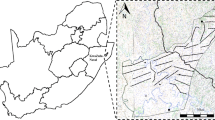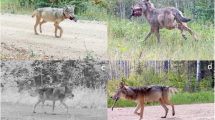Summary
The relationship between pack size and two parameters of reproductive success (litter size at 7–8 months and pup weights at 5–6 months) were determined for two wolf (Canis lupus) populations in northern Minnesota. Pup weights were not correlated with pack size for either population. Litter size, however, was correlated with pack size, but the direction of the relationship varied between the two study populations.
In the superior National Forest, where prey were scarce and the wolf population was declining from high densities, litter size and pack size were inversely related. Pairs produced more surviving pups than did larger packs with one or more potential helpers. In the Beltrami Island State Forest, where prey were relatively abundant and the wolf population was increasing, pack size and litter size were positively correlated. The results suggest that ecological factors, such as prey availability, affected the ability or willingness of various pack members to provide food or other care for the pups.
The lack of correlation between number of auxiliaries and number of pups in canid populations with low and declining prey densities may be explained on the basis of heterogeneous prey density resulting in drastic annual variation in litter production. No study to date has measured the actual benefit that pups derive from helping by auxiliaries, and the costs and benefits of it. The relationships discussed herein can be considered valid only after such research is completed.
Similar content being viewed by others
References
Ballenberghe V van, Mech LD (1975) Weights, growth and survival of timber wolf pups in Minnesota. J Mammal 56:44–63
Ballenberghe V van, Erickson AW, Byman D (1975) Ecology of the timber wolf in northeastern Minnesota. Wildl Monogr 43:1–43
Bekoff M, Wells MC (1980) The social ecology of coyotes. Sci Am 242:130–148
Bekoff M, Wells MC (in press) Behavioral ecology sympatric coyotes: social organization, rearing patterns, space use, and resource defense. Z Tierpsychol
Brown JL (1974) Alternate routes to sociality in jays — with a theory for the evolution of altruism and communal breeding. Am Zool 14:61–78
Brown JL (1978) Avian communal breeding systems. Annu Rev Ecol Syst 9:123–155
Brown JL, Dow DD, Brown ER, Brown SD (1978) Effects of helpers on feeding of nestlings in the grey-crowned babbler. (Pomatostomus temporalis). Behav Ecol Sociobiol 4:43–59
Brown JL, Brown ER, Brown SD, Dow DD (1982) Helpers: effects of experimental removal on reproductive success. Science 215:421–422
Camenzind FJ (1978) Behavioral ecology of coyotes on the national Elk Refuge, Jackson, Wyoming. In: Bekoff M (ed) Coyotes: biology, behavior, and management. Academic Press, New York, pp 267–294
Emlen ST (1978) The evolution of cooperative breeding in birds. In: Krebs J, Davies NB (eds) Behavioral ecology: an evolutionary approach. Sinauer, Sunderland (Massachusetts), pp 245–281
Emlen ST (1982) The evolution of helping. I. An ecological constraints model. II. The role of behavioral conflict. Am Nat 119:29–39 and 40–53
Fentress JC, Ryon J (1982) A long-term study of distributed pup feeding in captive wolves. In: Harrington FH, Paquet PC (eds) Wolves of the world: perspectives of behavior, ecology, and conservation. Noyes, Park Ridge (New Jersey), pp 238–261
Floyd TJ, Mech LD, Nelson ME (1979) An improved method of censusing deer in deciduous-coniferous forests. J Wildl Manage 43:258–261
Frame LH, Malcolm JR, Frame GW, Lawick H van (1979) Social organization of African wild dogs (Lycaon pictus) on the Serengeti Plains, Tanzania 1967–1978. Z Tierpsychol 50:225–249
Frenzel LD (1974) Occurrence of moose in food of wolves as revealed by scat analyses: a review of North American studies. Nat Can 101:467–479
Fritts SH, Mech LD (1981) Dynamics, movements, and feeding ecology of a newly protected wolf population in northwestern Minnesota. Wildl Monogr 80:1–79
Fry CH (1972) The social organization of bee-eaters (Meropidae) and co-operative breeding in hot-climate birds. Ibis 114:1–14
Haber GC (1977) Socio-ecological dynamics of wolves and prey in a subarctic ecosystem. PhD thesis, University of British Columbia, Vancouver
Harrington FH, Mech LD (1979) Wolf howling and its role in territory maintenance. Behaviour 68:207–249
Harrington FH, Mech LD (1982) Patterns of homesite attendance in two Minnesota wolf packs. In: Harrington FH, Paquet PC (eds) Wolves of the world: perspectives of behavior, ecology, and conservation. Noyes, Park Ridge (New Jersey), pp 81–109
Hersteinsson P, Macdonald DW (1982) Some comparisons between red and Arctic foxes, Vulpes vulpes and Alopex lagopus as revealed by redistributing. In: Cheeseman C, Mitsen R (eds) Telemetric studies of vertebrates. Proc Symp Zool Soc (Lond) 49:259–289
Johnsingh AJT (1980) Ecology and behaviour of the dhole or Indian wild dog Cuon alpinus Pallon 1811, with special reference to predator prey relations at Bindipur. Report to the World Wildlife Fund — Indian and International Appeals
Kuyt E (1972) Food-habits and ecology of wolves on barren-ground caribou range in the Northwest Territories. Can Wildl Serv Rep Ser 21:1–36
Leirfallom J (1970) Wolf management in Minnesota. In: Jorgensen SE, Falkner CE, Mech LD (eds) Proceedings of symposium on wolf management in selected areas of North America. US Fish Wildl Serv Spec Publ, Twin Cities, pp 9–15
Macdonald DW (1979) ‘Helpers’ in fox society. Nature 282:69–71
Macdonald DW (1980) Social factors affecting reproduction by the red fox, Vulpes vulpes. In: Zimen E (ed) The red fox: ecology-behaviour. Junk, The Hague, pp 123–175
Macdonald DW, Moehlman PD (1982) Cooperation, altruism, and restraint in the reproduction of carnivores. In: Bateson PPG, Klopfer PH (eds) Perspectives in ethology. vol 5. Plenum Press, New York, pp 433–467
Malcolm JR, Marten K (1982) Natural selection and the communal rearing of pups in African wild dogs (Lycaon pictus). Z Tierpsychol 10:1–13
Mech LD (1970) The Wolf: The ecology and behavior of an endangered species. Natural History Press, Garden City (New York)
Mech LD (1973) Wolf numbers in the Superior National Forest of Minnesota, USDA, For Serv Res Paper NC-97, St. Paul (Minnesota)
Mech LD (1974) Current techniques in the study of elusive wilderness carnivores. In: Pimlott DH (ed) Wolves. Proc 11th Int Congr Game Biol 11:315–322
Mech LD (1977a) Productivity, mortality, and population trends of wolves in northeastern Minnesota. J Mammal 58:559–574
Mech LD (1977b) Population trend and winter deer consumption in a Minnesota wolf pack. In: Phillips RL, Jonkel C (eds) Proc 1975 Predator Symp, University of Montana, Missoula (Montana), pp 55–83
Mech LD (1980) Making the most of radio-tracking — a summary of wolf studies in northeastern Minnesota. In: Amlander CJ Jr, Macdonald DW (eds) A handbook on biotelemetry and radio-tracking. Pergamon Press, Oxford, pp 85–95
Mech LD, Frenzol LD (1971) Ecological studies of the timber wolf in northeastern Minnesota. USDA For Serv Res Paper NC-52, St. Paul (Minnesota)
Mech LD, Karns PD (1977) Role of the wolf in a deer decline in the Superior National Forest. USDA For Serv Res Paper NC-148, St. Paul (Minnesota)
Mech LD, Knick ST (1978) Sleeping distance in wolf pairs in relation to breeding season. Behav Biol 23:521–525
Mochlman PD (1979) Jackal helpers and pup survival. Nature 277:382–383
Mochlman PD (1981) Reply to Montgomerie (1981). Nature 289:825
Moehlman PD (1983) Socioecology ofsilver backed and golden jackals (Canis mesomelas, Canis aureus). In: Eisenberg JR, Kleiman DG (eds) Recent advances in the study of mammalian behavior. Am Soc Mammal Spec Publ 7:423–453
Montgomerie RD (1981) Why do jackals help their parents Nature 289:824–825
Murie A (1944) The wolves of Mt. McKinley. US Nat Park Serv Fauna Ser 5, Washington (DC)
Packard JM, Mech LD, Seal US (1983) Social influences on reproduction in wolves. In: Carbyn L (ed) Proc Canadian Wolf Workshop. Can Wild Serv Rep (in press)
Peterson RO (1977) Wolf ecology and prey relationships on Isle Royale. Nat Park Serv Sci Monogr 11:1–210
Pimlott DH, Shannon JA, Kolenosky GB (1969) The ecology of the timber wolf in Algonquin Provincial Park. Ontario Dept Lands For Res Rep (Wildl) 87:1–92
Rausch RA (1967) Some aspects of the population ecology of wolves in Alaska. Am Zool 7:253–265
Ricklefs RE (1975) The ecolution of co-operative breeding in birds. Ibis 117:531–534
Ryden H (1975) God's dog. Coward, McCann, Geoghegan, New York
Seal US, Mech LD, Van Ballenberghe V (1975) Blood analyses of wolf pups and their ecological and metabolic interpretation. J Mammal 56:64–75
Siegel S (1956) Nonparametric statistics. McGraw-Hill, New York
Skutch AF (1961) Helpers among birds. Condor 63:198–226
Stenlund MH (1955) A field study of the timber wolf (Canis lupus) on the Superior National Forest, Minnesota. Minn Dep Conserv Tech Bull 4:1–55
Sullivan JO (1978) Variability in the wolf, a group hunter. In: Hall RL, Sharp HS (eds) Wolf and man: evolution in parallel. Academic Press, New York, pp 31–40
Sullivan JO (1979) Individual variability in hunting behavior of wolves. In: Klinghammer E (ed) The behavior and ecology of wolves. Garland Press, New York, pp 284–306
Zahavi A (1974) Communal nesting by the Arabian babbler. Ibis 116:84–87
Zimen E (1975) Social dynamics of the wolf pack. In: Fox MW (ed) The wild canids: their systematics, behavioral ecology and evolution. Van Nostrand Reinhold, New York, pp 336–362
Zimen E (1982) A wolf pack sociogram. In: Harrington FH, Paquet PC (eds) Wolves of the world: perspectives of behavior, ecology, and conservation. Noyes, Park Ridge (New Jersey), pp 282–322
Author information
Authors and Affiliations
Rights and permissions
About this article
Cite this article
Harrington, F.H., David Mech, L. & Fritts, S.H. Pack size and wolf pup survival: their relationship under varying ecological conditions. Behav Ecol Sociobiol 13, 19–26 (1983). https://doi.org/10.1007/BF00295072
Received:
Accepted:
Issue Date:
DOI: https://doi.org/10.1007/BF00295072




